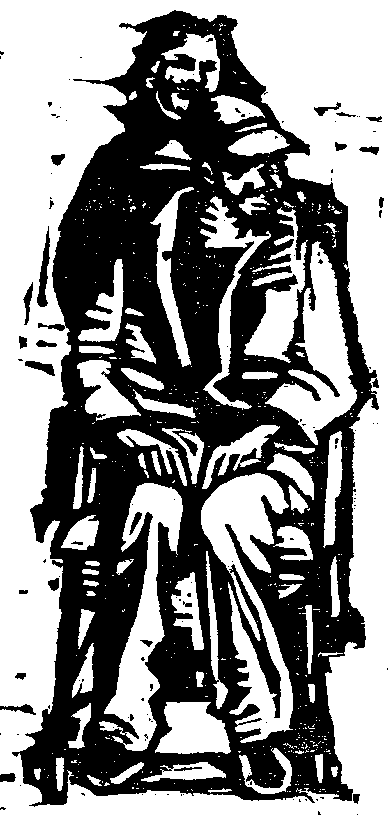 |
||||||||||||
|
November/December 2013
BY PAUL ROGERS
Today, U.S.VETS is America’s largest nonprofit provider of comprehensive services to homeless and at-risk military veterans. Its stated mission is the successful transition of veterans and their families through the provision of housing, counseling, career development, and support. Every day the L.A.-based organization houses and feeds more than two thousand veterans at eleven facilities in six states and the District of Columbia. Each year it helps three thousand veterans find housing and more than a thousand obtain full-time employment. U.S.VETS provides both transitional and affordable permanent housing in stable, sober environments. That includes case management services, medical referrals, therapeutic groups, and informal peer support. “It’s the full range of resources that homeless veterans need to really get themselves ready to become self-sufficient again,” said Steve Peck, U.S.VETS president and CEO. U.S.VETS began in 1993 as the Westside Residence Hall in the gritty city of Inglewood, twenty minutes southwest of downtown Los Angeles. At the time, there were some 24,000 veterans living on the streets of Los Angeles, according to Peck. Westside Residence Hall could initially house just five. As of January this year, according to the Los Angeles Homeless Services Authority, there were fewer than 6,300 homeless vets in L.A.—still a tragedy (nearly a tenth of homeless veterans nationwide), but a decrease of more than 70 percent in less than two decades, due in part to the efforts of U.S.VETS “If you’ve fallen into homelessness, a lot of things have gone wrong in your life, and so you deal with a lot of different bureaucracies in order to get yourself back straight again,” said Peck, the son of the late actor Gregory Peck and himself a Vietnam War veteran. “Los Angeles is such a big place, you can get lost in the bureaucracy. So we try to bring all that under one roof.” U.S.VETS houses nearly 1,300 formerly homeless or at-risk veterans—close to half of its clients nationwide—in the Los Angeles area: around 600 at its original Inglewood campus (now known as U.S.VETS-Los Angeles and still its largest); 550 at another in nearby Long Beach; and 125 in Riverside, an hour inland. Most are men, but U.S.VETS-Long Beach also provides specialized services for the approximately 45 women who live there. U.S.VETS also has facilities in Arizona, Hawaii, Missouri, Nevada, Texas, and Washington, D.C. Homeless veterans connect with U.S.VETS through both walk-ins and via outreach programs at places such as soup kitchens, churches, parks, and beneath bridges.
Towering over a nondescript street of low-slung business units, U.S.VETS’ Inglewood campus, which was previously a Northrop Grumman and college dorm, offers veterans a bed, breakfast, sack lunch, and dinner. For their first two years of residence, clients eat for free at the facility’s dining hall; thereafter, each meal costs a flat four dollars. A round-the-clock office furnishes everyday needs, from laundry detergent to shampoo. A career center provides free Internet and phone access, and bus tokens are provided to attend job interviews. Numbered mailboxes allow clients to mask their residency in a homeless facility from potential employers. The Inglewood facility also includes a small, shabby library; a mini gym; and a TV and game room. Although it outwardly resembles an aging Holiday Inn, U.S.VETS-Los Angeles is no hotel. “It’s not a place where you just come and lie down,” said Levi Cunningham, the site’s genial veteran service manager. “Clients have got to get up and do something constructive during the course of the day, like look for employment.” U.S.VETS has created a structured back-to-work program aimed at helping homeless veterans back into employment and paid accommodation, be it a room on their campus or, ideally, a place in the community. There’s no sense of aimlessness at its well-maintained Inglewood location, where most residents spend weekdays at work, out looking for work, or in school. “We keep them at it, and that’s the deal,” said Peck, seated in one of the boxy building’s faded street-level offices. “You’ve got to work the program that we lay out before you. And if you don’t want to do that, maybe this isn’t the spot for you. We have high expectations, and by and large clients live up to those expectations.” U.S.VETS’ transitional Veterans in Progress (VIP) program, which is offered at all its sites, is intended for veterans who might walk in with nothing more than the clothes on their backs. Though VIP is aimed at linking veterans to permanent housing and includes an aggressive job-search strategy, its clients often need much more than shelter and work. “They have past legal issues; they’ve lost touch with their kids,” said Peck. “So we help them kind of put their lives back together and get them back on track.” VIPs consistently average 80 percent employment and 65 percent successful transition to long-term or permanent housing. U.S.VETS also can help its clients obtain treatment for drug and alcohol problems, as well as with emotional and psychological issues. Its clinical director for Los Angeles, Dr. Jack Mayhall, is the former chair of a graduate school psychology department. The Inglewood site has vans to run clients to and from the nearby VA Medical Center. Upon admittance, U.S.VETS-Los Angeles’ transitional clients are housed in two- or three-person bedrooms organized into quads of four around a communal living room and bathroom. While these white-painted accommodations are hardly cozy, they are functional, kept-up, and clean. This transitional housing is intended to take its occupants to a point, financially and emotionally, where they can take care of themselves. “Let’s figure out what are the things you need to work on, whether it’s behavioral issues; whether it’s your drug and alcohol problem; whether you just can’t find work,” said Peck. “We do a plan with clients, what’s called a ‘benchmark plan,’ and prioritize these issues.” According to Peck, U.S.VETS’ transitional clients’ average length of stay has increased since the economic downturn, from about four months to around six months. “Now there’s a lot of chronically homeless; a lot of guys with mental illness,” he explained. “That’s a more challenging issue, and they need more time to get to a point where they can become self-sufficient, either through employment or disability [benefits].” U.S.VETS’ Inglewood clients literally move up in the world as they progress through their programs. A new arrival will likely get a bed in a three-person room on a lower floor of the eight-story building but, if he stays on-track, may move on to sharing with just a single roommate. Upper floors (and an adjacent smaller structure opened in 2011) are reserved for clients in the facility’s long-term supportive housing program. These residents, who are either employed or receiving benefits, occupy double or single rooms and pay rent ranging from $330 to $798 per month depending on level of income. In some cases, rent is as little as $75 a month for clients with VA Supportive Housing vouchers. “This place has been tremendous for me,” said Jesse Aragon, a Vietnam veteran who fell into homelessness in 2000 after suffering delayed post-traumatic stress disorder. He has lived at U.S.VETS-Los Angeles since 2002. “If it wasn’t for this place, I would have died a long time ago,” he said. Aragon, who served as a medic with the 1st Air Cavalry Division in 1966-67, was married with two sons, earning a six-figure salary, and living the American Dream in the nearby coastal city of Ventura before flashbacks drove him to drink. He quit his job, divorced, and was living in his car when L.A.’s VA hospital directed him to U.S.VETS. At age 69, Aragon now lives on Social Security and service-related disability benefits, but until 2007 he paid his way at U.S.VETS by working as a security guard. He pays $460 monthly rent for a single room on the fourth floor, has a girlfriend, and is receiving treatment for bladder cancer through the VA. “I’m an old-timer here, but there’s people who have been here longer than me,” said Aragon. “One guy’s been here thirteen years; another one’s been here fifteen years.” U.S.VETS-Los Angeles has helped more than ten thousand veterans.
All of this work costs money. According to Peck, U.S.VETS’ national budget for 2012 was $31 million, which covers all eleven of its campuses, plus community programs such as homeless prevention services. The budget for the Inglewood facility alone is around $5 million, he said. “About 70 percent of that comes from government contracts—the VA, Housing and Urban Development, and the Department of Labor. The rest comes from fund-raising—state, county, city—anywhere we can find money,” Peck said. U.S.VETS writes grant proposals to foundations and corporations. Each of its sites has a development team that reaches out into the community for support. Private individuals can make donations via its website. Peck feels that U.S.VETS is too reliant on government funding. In 2009 President Obama and the VA announced a goal of ending veteran homelessness by the end of 2015. The effects of this ambitious initiative are palpable. There has been a 17 percent decrease in veteran homelessness nationally since 2009, according to the U.S. Interagency Council on Homelessness. But Peck worries about what will happen when this funding bubble bursts. “There’s more money being given now, today, than I think will ever be given again,” he said. “That number’s going to go back down, and what’s going to happen after 2015? We’re not going to get everyone off the street. So it will be interesting to see what happens when we pull out of Afghanistan in 2014 and when 2015 comes and goes.”
According to the VA, nearly half of America’s homeless veterans served during the Vietnam era, in large part simply because more veterans served during Vietnam than at any other time since World War II. “The Vietnam era left veterans scarred in a lot of ways that made it impossible or difficult for them to reintegrate back into the community. A lot of them had undiagnosed mental conditions,” said Harold McGee, a Vietnam-era Navy veteran who was once borderline homeless himself and now works as an outreach and housing specialist at U.S.VETS-Los Angeles. “The Afghanistan and Iraq veterans now have more benefits; more help with these combat-type issues than we did, because back then they didn’t do that. They just considered us alcoholics or drug addicts. They didn’t look at the fact that these problems were recurring issues due to things that happened in Vietnam.” “If they’ve let these problems go on all these years, that’s a different psychological problem than a guy who was in combat six months ago,” said Peck. “Those behaviors are ingrained. So it’s a much more intractable problem, and we have to deal with it on that basis.” For U.S.VETS, this can mean facilitating longer-term therapy for Vietnam veterans and, as many are too old to return to the workforce, ensuring that they receive appropriate disability benefits.
U.S.VETS measures success not just in terms of numbers of homeless veterans housed or employed, even though 64 percent of its 20,000-plus clients have made successful transitions into permanent housing and achieved self-sufficiency. Success is measured also through less quantifiable, personal reactions. To this end, U.S.VETS conducts assessment surveys with clients as they enter the facility and once again as they leave. “One of the common themes that comes up over and over again is that U.S.VETS helped me find a sense of myself again,” said Mayhall. “You provided me not only with a structure for safety and food and shelter and training, but the respect that I was treated with, that was lacking, and helped me have a better sense of self and higher levels of self-esteem, which gave me the courage to go out and face the world.” “I’ve seen U.S.VETS clients save money; be able to get a place; get their families back together,” McGee said. “And when a man feels as though he’s really doing what a man’s supposed to, his walk changes; his whole outlook changes.” U.S.VETS’ efficacy to date can be attributed not just to energy and industry, but also to its innovative approaches to reducing veteran homelessness.
“U.S.VETS came along and people who might have economic issues could come right into our program. That took them off the street; helped them get stabilized in their employment, save some money; and then they can go back into the community productive—become tax-paying members of our community again.” U.S.VETS has created many pioneering, specialized programs, including its ADVANCE Women’s Program, which began at U.S.VETS-Long Beach in 2001. “About 70 percent of the women coming to us have been sexually assaulted while in the military or before,” said Peck. “ADVANCE is a twelve-week treatment program to help them get past that.” The organization also offers a Non-Custodial Fathers program, aimed at reconnecting homeless veterans with their estranged children; Supportive Services for Veteran Families, which helps low-income veteran families find affordable housing; and Veterans With High Barriers, which addresses obstacles to veterans securing employment, such as age, criminal records, and long-term joblessness. For all of their achievements, Peck and his staff still maintain a dynamic, self-examining culture. “I think we’re going to have to get better at helping to create new affordable housing in the community,” Peck said. “There simply aren’t enough affordable housing units to put homeless veterans in.” Accordingly, U.S.VETS is working with developers to create affordable real world rental units that offer a middle path for a veteran transitioning from living on one of the organization’s campuses to having his or her own home. Ivan Mason, U.S.VETS-Los Angeles’ executive director, sees improved efficiency as crucial to the organization’s forward progress. He aspires to coordinated entry systems which could, among other benefits, keep better track of clients moving between the organization’s facilities. “We need to get to a place where we can share real-time information across our systems, because we’re so big now,” he said. For Mayhall, expanding U.S.VETS’ clinical services is key to better supporting veterans on the road to material self-sufficiency and to a self-sufficient mindset. “The concept of ‘home,’ for example, involves treatment and clinical services and counseling,” he explained. “I’d like to see U.S.VETS get more involved, like having its own clinic to help clients in more of a psychological way.” U.S.VETS soon will open a new, 85-bed program in Washington, D.C., and is raising funds to expand its Riverside facility, where it recently started a second women’s program. It also is working with other veterans service organizations to create a one-stop service center inside the historic Patriotic Hall in downtown Los Angeles. “This ain’t for everybody,” Cunningham concluded, surveying the grassy courtyard of the Inglewood campus from one of its breezy upper walkways. “But for the ones who are trying, we’re going to try right with you. We’re going to make two steps to your every one; we’re going to really, really try hard to make it happen for you.”
|
||||||||||||
|
|
||||||||||||
|
||||||||||||
8719 Colesville Road, Suite 100, Silver Spring. MD 20910 | www.vva.org | contact us |
||||||||||||










 It’s hard to drive on Los Angeles’ famously congested streets without seeing at least one forlorn figure at an intersection clutching a crude “homeless veteran” sign. This is the reality that, twenty years ago, spawned U.S.VETS.
It’s hard to drive on Los Angeles’ famously congested streets without seeing at least one forlorn figure at an intersection clutching a crude “homeless veteran” sign. This is the reality that, twenty years ago, spawned U.S.VETS. “We verify their veteran status and if they’re in desperate straits. We can get them a bed tonight, either here or somewhere else,” said Peck, a former filmmaker who served as a lieutenant in the 1st Marine Division near Da Nang in 1969-70. “We do that even before they prove their veteran status—the number who lie about that is so small, it’s not worth keeping a guy out in the cold.”
“We verify their veteran status and if they’re in desperate straits. We can get them a bed tonight, either here or somewhere else,” said Peck, a former filmmaker who served as a lieutenant in the 1st Marine Division near Da Nang in 1969-70. “We do that even before they prove their veteran status—the number who lie about that is so small, it’s not worth keeping a guy out in the cold.” “There were no programs right at the beginning of U.S.VETS that helped veterans without substance abuse issues,” said Kevin Kincey, outreach coordinator for U.S.VETS-Los Angeles. “So if a veteran didn’t have a substance abuse problem and he was just homeless in the late ’80s and early ’90s, he couldn’t go into a VA-sponsored program.
“There were no programs right at the beginning of U.S.VETS that helped veterans without substance abuse issues,” said Kevin Kincey, outreach coordinator for U.S.VETS-Los Angeles. “So if a veteran didn’t have a substance abuse problem and he was just homeless in the late ’80s and early ’90s, he couldn’t go into a VA-sponsored program.